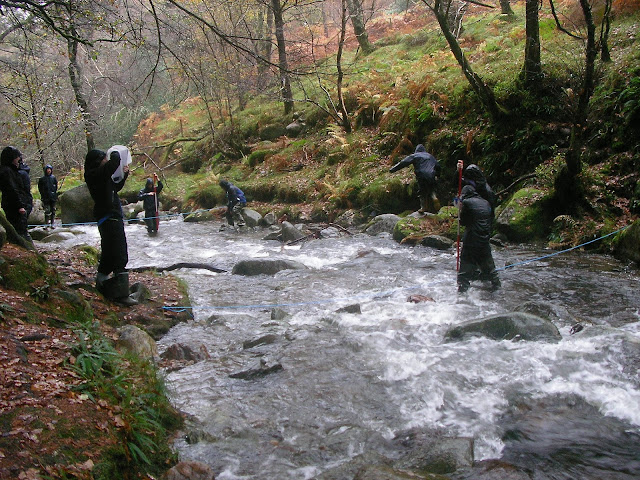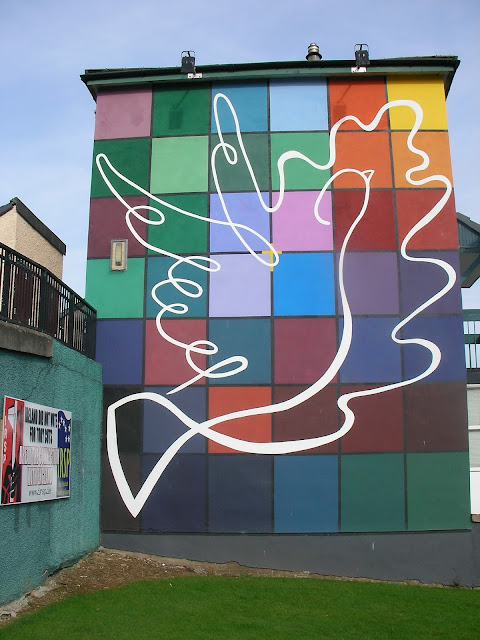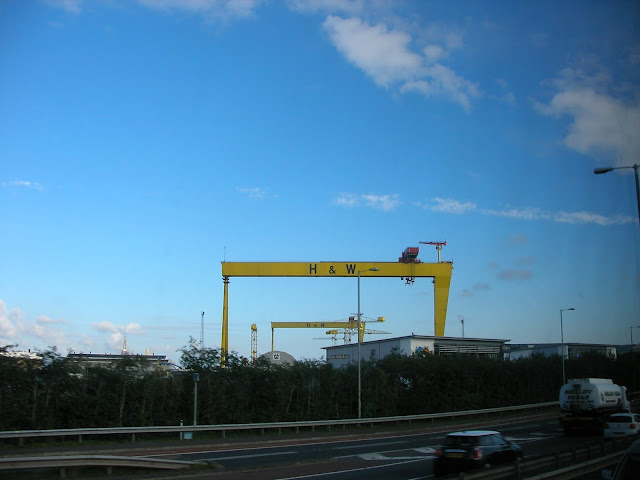1st Year History Trip
Mr. Fitzpatrick, Mr Finn, Ms Hargan and Ms Hand brought us on a trip to Ferrycarrig National Park in Wexford. Unfortunately it was a miserable day and rained for most of the time. It took us about an hour and a half to get there and we talked among ourselves for the journey. When we got to the park we watched a short movie to start off. Our tour guide was very nice and she dressed up as a Viking.
First we "entered" the Stone Age in the Mesolithic Period. We got to see replicas of their houses from that time built with wattle and daub with thatch on top.
Next came the Bronze Age. We got to see the difference between the Bronze Age and Stone Age dwellings.
Then we got to see a Celtic Ringfort (Rath) from the Iron Age.
We got to see a church and a few houses from Early-Christian Ireland. We got to see a cross aswell.
We got to see a horizontal water wheel and a Fulchta Fiadh (from the Bronze Age).
We went out to a crannóg in the middle of a lake. After the crannóg, we got to see a Viking long-house and longboat.
We also got to see a few types of graves and a stone circle on the way around.
When we are finished looking around the park we had our lunch and went home. We had a great day out.
Geography Field Trip November 2015
On Monday the 9th of November, the Sixth Year
Geography class went to Glendalough to perform the customary Leaving
Certificate field study on rivers. Unfortunately, we were not lucky enough to
have good weather on the day, and were soaked through before we even got to the
river. Once we arrived, our class were more than happy to use the waders
provided and joyfully hopped into the river. However, some of the waders had a
few holes in them, and in the words of Jack Conroy, “I’ve been compromised”.
After measuring different aspects of the LugDuff Brook River, we stopped for a
few pictures and made our way back to the Education Centre through the wind,
rain, and Gary poking us with a ranging pole. After a spot of lunch, Mr. Murphy
thought it was a great idea to go for a walk back out in to the storm and
explore the miners’ village and enjoy the breathtaking views.
Eoin, Columbus
Derry and Belfast Trip 2015
Outside the Guildhall Derry
The remains of the Walker Monument
Cemetery of brigade
Looking down at Bogside beside the Roaring Meg cannon on the city walls
Rubber Bullet
Plastic Bullet
Model of original Walker monument
The Orange Lodge Hall Derry
The Peace Bridge Derry
Bloody Sunday memorial
John Hume
Left to right: Rubber Bullet, Plastic Bullet, Bullet used to kill the innocent victims on Bloody Sunday, Nail bomb- type planted on victims by British Army
Mural of Bloody Sunday
Mural of Battle of the Bogside
Mural of Anne McGavigan killed by a plastic bullet
Bogside Mural
Bogside Mural
Bogside Mural - Peace Dove from darkness into light
Bogside Mural Peace Builders
Bogside Arts Centre
Irish involved in Spanish Civil War
Sandy Row Belfast
Sandy Row Belfast
Mural on the International Wall on Falls Road, Belfast
Mural on the International Wall on Falls Road, Belfast
Mural on the International Wall on Falls Road, Belfast
Mural on the International Wall on Falls Road, Belfast
Mural on the International Wall on Falls Road, Belfast
Mural on the International Wall on Falls Road, Belfast
Mural on the International Wall on Falls Road, Belfast
Mural on the International Wall on Falls Road, Belfast
Our next stop was the Apprentice Boys’ Hall. Unexpectedly, our guide (an Apprentice from the Campsie Club) showed no facets of the self-righteous Apprentice Boys that taunted and oppressed Catholics for decades. His attitude was a reflection of how far ecumenism and the peace process had come in Derry since the 1998 Good Friday Agreement. He mentioned how the issue of ‘Londonderry’ or ‘Derry’ only concerns people outside the county and how the annual Apprentice marches pass off peacefully. He guided us through the momentous Siege of Derry 1689. He was unbiased and his modest attitude was something which took many of us by surprise.
That evening we checked-in to the hotel after a more than active day. After dinner, we had a short quiz (a pound to play), in which the victors took the cash. Thankfully, I was one of them! We soon retired to our beds to revitalise ourselves for the next day.
The next morning, we made our way to the Foyle Peace Bridge, which joins the unionist ‘Waterside’ with the largely nationalist ‘City/Bogside’. This piece of architectural beauty is one of the dividends of the peace process and acts as a symbol of ecumenism. Following this, we paid a visit to the Bloody Sunday Museum, an archive of the events leading up to Bloody Sunday 1972 and the infamous day itself. We were also shown the various types of bullets (eg rubber) used by the police forces and British Army against the Civil Rights protestors. From here, our tour guide took us to the ‘Bogside’ of Derry. We visited famous streets and murals and discussed some of the events of “The Troubles”. Our guide, a former IRA prisoner, had a wealth of information. He explained the various murals, including the famous ‘Free Derry Wall’, and told us some personal stories. His first-hand accounts made him a great guide and he was well received by everyone from St. Brendan’s.
After lunch, we made the journey to Belfast. We paid a visit to the Ulster Museum, which included a detailed visual account of “The Troubles” and its effect on the province. The Museum contained a lot of relevant information which will be useful for our Leaving Cert Examination. We then took in the infamous Falls Road (nationalist) and Shankill Road (loyalist). Both working class areas, decorated with political/religious murals, are divided by the ‘peace walls’. These walls, originally designed to stop sectarian violence, are daunting and really highlighted the sectarian tensions that exist in Belfast, particularly for us outsiders. We made a stop at a section of the wall where we could write our very own ‘words of wisdom’ and push for peace. For us, the sight of the wall amplified the tensions in Belfast and gave us a far better understanding of the divisions. In this day and age, most people are waiting for Belfast to have a Berlin moment and tear down the wall.
Rory, Columbus
H Block
On the final day, we began with a visit to Stormont parliament building. Whilst
a wonderful piece of architectural beauty (perfect for photographs), this
imperious building acted as a symbol of unionist triumphalism. From Stormont, we made our way into the city
centre to learn more about the Belfast Blitz of 1941. Our tour guide showed us
the key sites from the horrific events of 1941, including City Hall, the
shipyards and the working class area of New Lodge. We also visited the NI War
Memorial Museum which offered plenty of information and facts. This was particularly beneficial with the
Blitz being a case study on our course. Afterwards, we made a quick stop at
Queen’s University Belfast. Steeped in history, the building certainly lived up
to its billing. With our trip to Northern Ireland drawing to a close, we went
into the city centre for lunch and any last minute shopping. With everything done,
we got back on the coach and made our way back to Bray. In full, the trip was a fantastic journey from start to finish and will live long in the minds of those who travelled.

















































































No comments:
Post a Comment